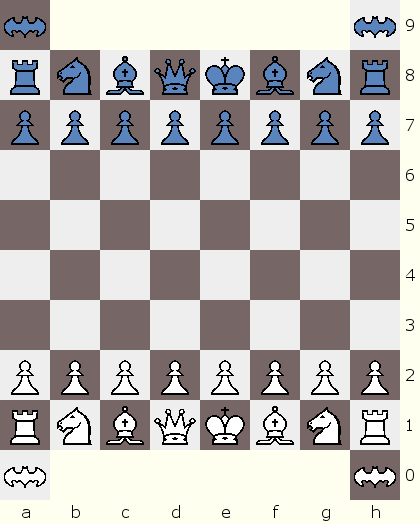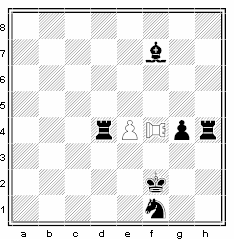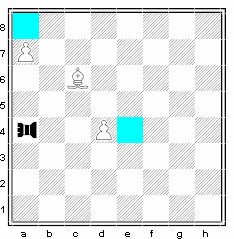Flying Bombers with Hangars
This game was conceived as a standard board equivalent of Flying Bombers Grand Chess, and the author discovered that it was quite a playable version. The author recommends Flying Bombers Grand Chess but if you cannot find a larger board then this game is ideal.The standard board is extended by one square at each wing to form a hangar which houses the flying bomber. A standard chessboard can be modified in some way or the squares can even be visualized by the players.
The game proceeds exactly as a regular chess game except for the addition of these new pieces, and the 4 new squares.
The flying bombers may be best developed later in the game since they are blocked by the other pieces and pawns initially.
After castling, the extra square may offer some added protection for the king.
Board Setup
 |
Start Position for white. (black mirrors white)
flying bombers on a0, h0 Rooks on a1,h1 knights on b1,g1 bishops on c1, f1 queen on d1 king on e1 |
The Bird’s (Flying Bomber’s) Moves
*The flying bomber's shape resembles a bat, hence the iconographic symbols used. However, the flying bomber is also referred to as the "Bird" - a common nickname given to fighter planes. The choice of name is left to the player.
The flying bomber's odd combination of long-range and short-range moves makes it a deadly weapon against an unsuspecting opponent.
Standard Move:- The flying bomber eliminates an enemy piece by flying over it, and landing on THE empty square immediately after it on the same orthogonal line. It cannot fly over or capture a second piece or land on any square beyond the first empty square.
- The flying bomber can fly along any amount of empty squares (1-9) orthogonally, but not over any friendly pieces. This is identical to the movement of a rook.
Special Move: the Helicopter Landing
This is a special maneuver that enables the bird to fly over the adjacent square, (jumping over, if occupied by friendly piece or eliminating if occupied by enemy piece) and land like a helicopter on a square exactly 2 squares away, capturing if possible on this square. It can capture two pieces in this manner.Essentially, it combines its standard move with that of a two space orthogonal jumper.
This peculiar short-range prowess in more detail:
- The Flying Bomber can fly over one friendly piece adjacent to it (left, right, up or down) and land on an empty square immediately after it. When it flies over an adjacent friendly piece, its range is limited to two squares.
- If an enemy piece is exactly 2 squares away orthogonally and no other piece is in-between, then the flying bomber can capture the usual way by flying over it and landing on the empty square after it. It can also capture by landing on the same square as the enemy.
- If two enemy pieces lie on the same line, the first one adjacent to the flying bomber, and the next two squares away, then it can eliminate both pieces by landing on the square of the second enemy piece. (see diagram 1) It cannot fly over the second enemy piece.
- Similarly, if there was a friendly piece in immediate vicinity of the flying bomber, and an enemy piece right after it, then the bird can fly over the friendly piece and destroy the piece right after by landing on the same square. Here too it cannot fly over beyond the enemy piece as it cannot fly over two pieces.
- The Flying Bomber needs at least one square to fly over for a bombing. e.g. it can destroy any enemy piece in its vicinity (1 square to left, right, up or down) by flying over it and landing on the empty square after it, but if a friendly piece occupies a square immediately after the enemy piece, no capture can be made. (see diag 2)
- It must capture the enemy piece it jumps over. (capturing is not optional).
It is easier to remember the flying bomber moves as a combination of the standard move with the move of the Dabbabah - a leaping move two squares in any orthogonal direction.
 diag 1 (sideways rook rep. flying bomber) |
Diag. 1: The flying bomber on f4 is posing multiple threats to black's pieces.
It is threatening to destroy the black bishop on f7 by moving f4-f8. Using its special 2 square helicopter capability, it is threatening the black rook on d4 by moving f4-d4 (flying over its own piece and bombing/landing on d4). It cannot land on any squares beyond d4. This same short-range prowess gives it the ability to threaten f4-h4, flying over and bombing pawn on g4 and landing/bombing rook on h4. Note that the bomber cannot move to g4 by capturing the pawn, it must eliminate both the pawn and the rook. If there was no rook on h4 then the bomber can just capture the pawn by moving f4-h4. Note that the bird IS giving check to the king because it is exactly 2 squares away, and the bird can land on f2. However the bird is not threatening the knight on f1 since it is more than 2 squares away and there is no empty square beyond it. If the king moves, the knight will not be under attack either. |
 diag 2 (sideways rook rep. flying bomber) |
Diag 2: Here the Flying Bomber is hampered by Black’s Pieces.
It is not checking the king at d7 because there is no empty square behind it (and it is not exactly 2 squares away from it). The rook on d8 is pinned, because moving it would enable the king to be captured. However, the king can simply move away and the rook on d8 is not threatened because there is no empty square beyond it. The rook on e4 is adjacent to the flying bomber and threatening it. But the Flying Bomber cannot do anything because the white pawn occupies f4 and the bomber needs an empty square after its target. If f4 was an empty square, the bomber could capture the rook, and if there was another enemy piece on f4 instead of the white pawn, then the bomber could have captured both pieces. The Flying Bomber does attack the pawn on d2. It can fly d4-d1 OR move d4-d2 to eliminate the pawn. Because it is 2 squares away, the bomber can land on the same square as its target. |
 diag 3 (sideways rook rep. flying bomber) |
Diag 3:
Here the black Flying Bomber is threatening white’s pawns at d4 and a7.
However, the white bishop is defending both pawns (colored squares). To make matters worse the bishop is also attacking the bird! |
Strategical Considerations
- Endgame: During the endgame, flying bombers can work well against pawns. The short-range double capture /leaping powers of the Flying Bomber can pose a serious threat to pawns, so the side with more pawns should attempt to exchange off both flying bombers before they prove to be a liability.
- Ability to Checkmate: The flying bomber with the aid of the king still cannot checkmate a lone king It cannot check the king at the edge of the board unless it is two squares away. There are some situations where it could mate but it cannot be forced.
-
Relative Value:
The value of the flying bomber relative to the rook is hard to determine, but as a general rule, the rook is a bit more
powerful than the flying bomber whose action can be easily blocked.
It is worth approx 4 pawns.
Play the Game
Play Flying Bombers with Hangars|
If you would like to email the chess variant inventor directly: inventor@chess.computerwebservices.net
|

